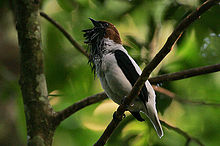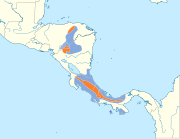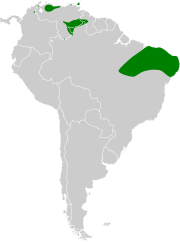Neotropical bellbird
| Neotropical bellbird | |
|---|---|

| |
| Bearded bellbird (Procnias averano) | |
| Scientific classification | |
| Domain: | Eukaryota |
| Kingdom: | Animalia |
| Phylum: | Chordata |
| Class: | Aves |
| Order: | Passeriformes |
| Family: | Cotingidae |
| Genus: | Procnias Illiger, 1811 |
| Type species | |
| Ampelis variegata[1] Gmelin, 1789
| |
| Species | |
Neotropical bellbird (or simply bellbird) is the common name given to passerine birds of the genus Procnias, found in the Neotropics. They are members of the cotinga family. They are all restricted to tropical or subtropical humid forested regions, often in low mountains or foothills. As indicated by their common name, they all have extremely loud calls that are reminiscent of a metal bell being rung.
Three of the four species are restricted to South America, while the last, the three-wattled bellbird, is restricted to southern Central America.[2]
They are strongly sexually dimorphic. Males have an at least partially white plumage, and facial wattles or bare facial skin. Females lack the wattles/bare facial skin, and are overall olive with yellowish streaks below.[2]
Taxonomy[edit]
The genus Procnias was introduced in 1811 by the German zoologist Johann Karl Wilhelm Illiger.[3] The name comes from Greek mythology, Procne was an Athenian princess who was metamorphosed into a swallow.[4] The type species was designated as the bearded bellbird by George Gray in 1840.[5][6]
The genus contains four species.[7]
| Common name | Scientific name and subspecies | Range | Size and ecology | IUCN status and estimated population |
|---|---|---|---|---|
| Three-wattled bellbird | Procnias tricarunculatus (Verreaux & Verreaux, 1853) |
Costa Rica, to eastern Honduras, Nicaragua and western Panama
|
Size: Habitat: Diet: |
VU
|
| White bellbird | Procnias albus (Hermann, 1783) |
Guianas, Venezuela and Brazil (Pará)
|
Size: Habitat: Diet: |
LC
|
| Bearded bellbird | Procnias averano (Hermann, 1783) Two subspecies
|
Venezuela and adjacent parts of Colombia and Guyana, Trinidad & Tobago and northeastern Brazil
|
Size: Habitat: Diet: |
LC
|
| Bare-throated bellbird | Procnias nudicollis (Vieillot, 1817) |
Atlantic forest and adjacent moist areas
|
Size: Habitat: Diet: |
NT
|
References[edit]
- ^ "Cotingidae". aviansystematics.org. The Trust for Avian Systematics. Retrieved 2023-07-24.
- ^ a b Snow, David W. (2004). "Family Cotingidae (Cotingas)". In del Hoyo, J.; Elliott, A.; Christie, D.A. (eds.). Handbook of the Birds of the World. Vol. 9: Cotingas to Pipits and Wagtails. Barcelona, Spain: Lynx Edicions. pp. 32–108 [104–105]. ISBN 978-84-87334-69-6.
- ^ Illiger, Johann Karl Wilhelm (1811). Prodromus systematis mammalium et avium (in Latin). Berolini [Berlin]: Sumptibus C. Salfeld. p. 228.
- ^ Jobling, James A. (2010). The Helm Dictionary of Scientific Bird Names. London: Christopher Helm. p. 317. ISBN 978-1-4081-2501-4.
- ^ Gray, George Robert (1840). A List of the Genera of Birds : with an Indication of the Typical Species of Each Genus. London: R. and J.E. Taylor. p. 34.
- ^ Traylor, Melvin A. Jr, ed. (1979). Check-List of Birds of the World. Vol. 8. Cambridge, Massachusetts: Museum of Comparative Zoology. p. 305.
- ^ Gill, Frank; Donsker, David; Rasmussen, Pamela, eds. (July 2021). "Cotingas, manakins, tityras, becards". IOC World Bird List Version 11.2. International Ornithologists' Union. Retrieved 7 December 2021.
Further reading[edit]
- Snow, D.W. (1982). The Cotingas: Bellbirds, Umbrella birds and their allies. British Museum Press. ISBN 0-19-858511-X




